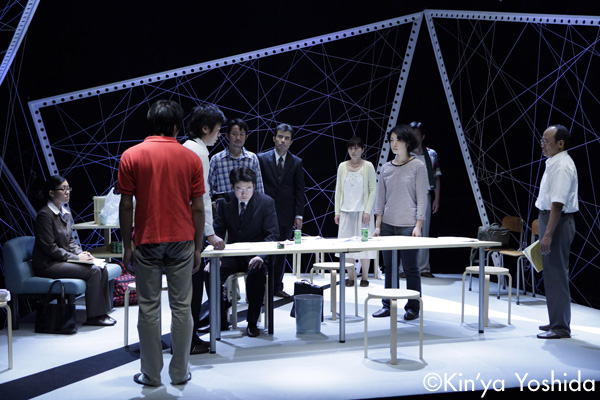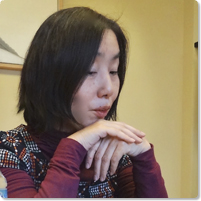Prologue: The year is 2006 and the scene takes place on the day of the opening of new Nichia Airline Safety Promotion Center. Takao Kawaji of the bereaved relatives association appears before the Center’s director, Kensuke Sakami. The two look back and sum up briefly the things that have happened since the accident until the present. The things that have been lost, the people they have lost. “I leave it to you to put the rest in words,” says Kawaji, encouraging Sakami to speak. As the lights go out we hear Sakami’s address.
It is 1990 and the scene is the warm-up room of a gymnasium in the town of Jindai-mura at the foot of Ousutaka Ridge, the crash site. Shinichi Iwanuma, an iron works owner who lost his wife in the crash, is preparing seminar papers to be handed out. He is joined there by Takumi Tsumura, a beverage company owner who lost his nine-year-old son in the crash. His wife, Kumiko, has not shown up yet. Today is a meeting to prepare for the seminar on airline safety research that Kawaji is organizing. Next, Kawaji comes in carrying some papers. He is a corporate researcher by profession, but ever since he lost his daughter in the accident he has dedicated endless efforts to study and advancement of improved airline safety, using his own money to travel to the U.S. to meet with experts in the field.
Participants arrive one after another. Among them are the seminar’s invited speaker, Dr. Yoshie Uwada, who performed the autopsies at the time of the accident, the son of the local inn, Tomoki Kudo, who is catering the lunch for the participants, Tsumura’s wife, Kumiko, who has been mentally unstable since the accident Eri Kurosaki, who lost her older sister that was one of the Flight attendants on flight 123, and the newspaper reporter Shigeyuki Matsuo. Arriving a little late is a Nichia Airlines maintenance division manager, Osamu Haijima, who has been supporting the activities of the bereaved relatives association by performing services such as clearing the mountain path up to the crash site for their yearly memorial pilgrimages. The participants exchange greetings here and there. But Kumiko leaves the room, throwing looks revulsion at the seminar organizers and Nichia Airlines representatives.
Then an unexpected pair of visitors arrive. It is Sakami of the Nichia Airlines Health and Welfare Department and his subordinate, Tetsuharu Kuwabara. Kawaji has known Sakami ever since he sought his cooperation once when Sakami was serving as the person in charge of handling affairs related to the crash, but today’s visit is completely unexpected. Sakami announces that he himself had been debating whether to come or not until this morning.
The Tsumuras return to the room, but Kumiko in particular shows disapproval at the presence of Sakami. She is angry at the presence of the Nichia Airline people and also at domineering behavior of Kawaji, who has a habit of making decisions by himself. Kumiko announces that the members from the Kansai branch of the bereaved relatives association that haven’t arrived yet will be withdrawing from the seminar. She reveals that there are a good number of members who don’t like the autocratic Kawaji’s business-like manner and lack of concern for the feelings of the bereaved families. But Kawaji is too concerned with pushing ahead with the seminar to be concerned about such emotional concerns.
Finally the explanation of the seminar outline begins. The plan is to hold a large-scale symposium aimed at re-examining the Nichia Airline Flight 123 crash at Ousutaka Ridge from the perspective of airline safety. The agenda is to include a seminar and debates with two authorities from the U.S. as guest speakers, as well as a hike up to the crash site.
Kawaji takes out a bent 10 yen coin that was found on the body of his daughter after the crash. He proceeds to tell how seeing this coin and his daughter’s crushed lower body arose doubts in him about the contents of the officially released autopsy reports that led him to feel at a re-investigation was necessary. Then he goes on to propose that finding out the reason why the four survivors were able to survive the crash is what they should be doing to make sure that the deaths of the remaining passengers were not completely in vain. He concludes that knowing the actual state of the bodies of the victims and the possible clues lying therein is an important task yet to be undertaken.
Uwada begins to speak in response to this by explaining the ghastly conditions under which the postmortem examinations were conducted at the time. The impact of the crash had torn the bodies of the 520 victims into thousands of body parts, most of which were unidentifiable. While expressing her remorse at the fact that proper examinations were not possible at the time given the grief of the bereaved families and the rapid pace of putrefaction in the summer heat, it gradually becomes clear that she thinks the same way as Kawaji.
What had the problems been? What about the configuration of the seat belts? Was there pilot error? Is there a question of responsibility for defects in the fuselage bulkhead maintenance? What about mistakes in the reports and contradictions in the corporate ethics? In the course of discussions, the feelings of anger and grief in the bereaved gradually returns to the levels they experienced immediately after the accident.
Besides the conflict of perpetrator and victim, the airline and the bereaved relatives association, the scene is ripe with dissent and grudges, in Kumiko’s criticisms against Kawaji, Iwanuma’s berating of Kumiko and the open wounds in the Tsumuras regarding their son’s death. When Matsuo begins taking photos as the quarrels reach their peak, he too becomes the target of criticism. One after another, the individual thoughts and grievances of the participants come to the surface. In fact, the ultimate wish of everyone here is the same: they grieve for the lost souls and pray that a tragedy like this never happens again. It is only the difference in the words they chose that drives them to mutual irritation and frustration.
It is only after reason and emotion have vented their wrath against each other through words that the waves of feeling can calm to ripples that everyone involved in this tragedy can realize that they all wish for the same thing.
Citing things he has heard from Kawaji about the conditions under which accident reports are made in the U.S., Iwanuma reminds everyone of their original ideal behind the association’s efforts by saying, “If we had that kind of report environment in Japan, the inherent Japanese spirit of cooperation would enable us to make even bigger improvements in airline safety than the Americans have.”
All of a sudden, Sakami picks up a piece of report paper, writes down his name and address and stamps his seal on it. He explains that in order to get a re-examination of this case the first thing to do is to collect signatures on a petition. Even though he is a Nichia employee, he chooses to sign a petition. “I can’t accept the position of speaker for this seminar. My first duty at this point, I feel, is to remain within Nichia,” says as he gets up to leave. Kuwabara follows suit by signing the petition and follows Sakami out.
Everyone is taken by surprise. Finally Tsumura suggests that they all eat the box lunches that have been prepared for the meeting. As long as the lunches are boxed, why not eat outside, they agreed, and everyone begins going about the preparations energetically.
Once outside, Kawaji apologizes to Kumiko by talking effusively about his lost daughter as if about a lover. Eri comes over to join them and reads to Kawaji something she had found in her research about the requirements for an airline crew that can work without accidents for a long time. She says she is determined to convince her parents to let her become a cabin attendant like her late sister. The journalist Matsuo takes a photo of Eri as she talks about her sister and her hopes for the future. This is a photo that sums up the day beautifully.
Epilogue: The setting returns to 2006 and the day of opening ceremony for the Nichia Airline Safety Promotion Center. The conversation of Sakami and Kawaji from the prologue is repeated. Sakami says there is an exhibit in the Center of records of an emergency landing that was successful due to training based on lessons learned from the Ousutaka accident. Kuwabara comes in to tell the two that the opening ceremony is about to begin.




